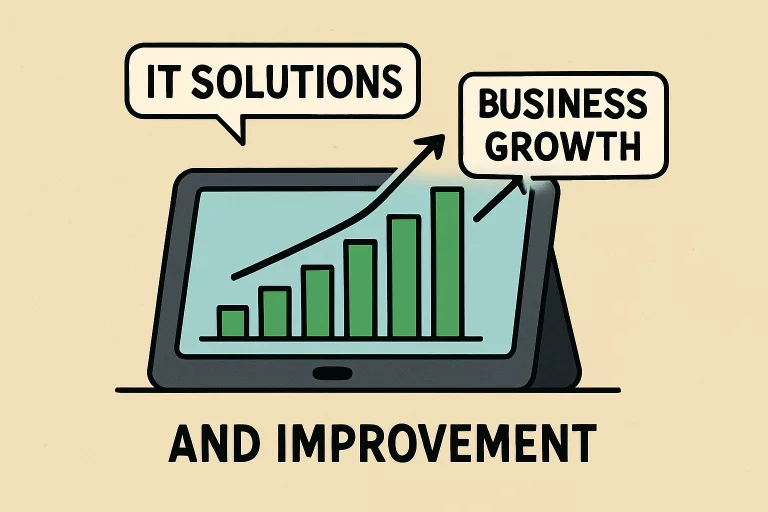In today’s fast-paced digital economy, businesses that strategically use IT solutions gain a competitive edge by enhancing adaptability, innovation, and value delivery. Technology has become central to business strategy, with tools like Managed IT Services driving productivity, efficiency, and customer satisfaction. As digital transformation continues, understanding IT’s role in business success is vital. Advanced IT ecosystems help streamline operations, protect data, and support scalable growth. Embracing digital change also enables businesses to stay agile and responsive to market shifts. There’s a growing link between IT maturity and overall success, highlighting the need for continual tech investment.
Streamlining Operations with IT Solutions
IT solutions, including Managed IT services, significantly improve business operations by streamlining processes and boosting productivity. Automation tools reduce the need for manual input in tasks such as payroll and scheduling, thereby minimizing errors and saving time. This allows employees to concentrate on strategic activities that drive growth. Integrated software enhances communication across departments, supporting seamless collaboration regardless of location. ERP systems unify operations such as inventory, finance, and supply chain management on a single platform, enabling quicker and more informed decision-making. Managed IT services also play a critical role by ensuring systems run smoothly, providing proactive maintenance, and addressing technical issues before they disrupt workflow. Cloud computing enhances flexibility by providing real-time access to documents and applications, facilitating remote work, and ensuring business continuity.

Enhancing Cybersecurity Measures
The rapid pace of digital transformation has significantly increased exposure to cyber threats, making cybersecurity a fundamental necessity for all businesses. Organizations now rely on advanced IT solutions that offer multi-layered protection to secure customer data, intellectual property, and core operational systems. Tools such as next-generation firewalls, encrypted communications, intrusion detection systems, and multi-factor authentication are key elements in these defenses. Regular penetration testing and continuous employee education further reinforce security by addressing internal risks, such as phishing and human error. A proactive investment in cybersecurity helps reduce financial losses, legal complications, and operational disruptions. Additionally, as data privacy regulations such as GDPR, HIPAA, and CCPA become stricter, robust IT frameworks help ensure compliance and build public trust. In today’s digital world, cybersecurity is not just about protection—it’s a critical pillar of long-term business resilience and customer confidence.
Building Scalable IT Infrastructures
Growth-oriented businesses require IT systems that evolve in tandem with their expanding operations. Scalability in IT infrastructure provides a strategic advantage by enabling companies to adjust capacity on demand. Cloud-based and hybrid solutions enable scaling up or down without the burden of purchasing or maintaining excess hardware. As companies enter new markets, experience spikes in demand, or undergo mergers, scalable IT ensures smooth transitions. Modern technologies such as virtualization, modular architecture, and containerization enable the rapid deployment of new services. These flexible solutions prevent legacy systems from becoming bottlenecks, allowing teams to innovate without disruption. Ultimately, scalable infrastructure frees up capital and resources, enabling businesses to focus on innovation and growth rather than being hindered by backend limitations.
Facilitating Data-Driven Decision Making
In the digital economy, data has emerged as a vital asset for shaping effective strategies. With the help of business intelligence platforms and analytics dashboards, companies can turn massive datasets into actionable insights. Real-time data analysis enables the identification of trends, monitoring of performance, and refinement of customer engagement strategies. These tools allow decision-makers to cut inefficiencies, reduce costs, and maximize return on investment. Emerging technologies, such as artificial intelligence and predictive analytics, take things further by forecasting demand, pinpointing risks, and suggesting new opportunities. As a result, businesses can transition from reactive to proactive planning, gaining a significant competitive advantage. Harnessing the full potential of data empowers organizations to make smarter, faster, and more confident decisions at every level.
Improving Customer Experience through Technology
Delivering a top-tier customer experience is a vital driver of long-term business success. Technology enables businesses to personalize interactions at scale, using tools like CRM platforms to track client history and preferences. These insights allow companies to anticipate needs and tailor communications more effectively. AI-powered chatbots and self-service portals provide instant solutions, improving convenience and reducing support wait times. With quicker resolutions and 24/7 access, customer satisfaction naturally increases. Leveraging data from support systems also helps businesses proactively identify and solve problems, as well as implement more effective loyalty programs. Ultimately, a tech-driven customer experience fosters higher retention, stronger brand loyalty, and more word-of-mouth referrals.
Future Trends in IT Solutions
Technology is evolving rapidly, reshaping how businesses operate across all industries. Artificial Intelligence and machine learning are automating decision-making and revealing actionable insights. IoT is enhancing device connectivity, offering real-time data to improve efficiency and asset management. Blockchain technology is gaining traction due to its ability to ensure secure and transparent transactions. Hybrid cloud environments are being widely adopted to strike a balance between flexibility, scalability, and cost control. These innovations collectively reduce manual effort and increase organizational agility. To remain competitive, businesses must actively monitor these trends and evolve their IT strategies accordingly.
Conclusion
IT solutions have evolved from being mere support functions to acting as the driving force behind business growth, innovation, and resilience. Whether by deploying IT Services for greater efficiency or adopting predictive analytics for sharper decision-making, companies that prioritize technology are positioning themselves for sustainable, long-term success. By aligning technology investments with strategic objectives, fostering a culture of digital transformation, and staying vigilant to emerging trends, organizations establish a foundation that not only supports current aspirations but also unlocks future potential in an ever-evolving marketplace.
